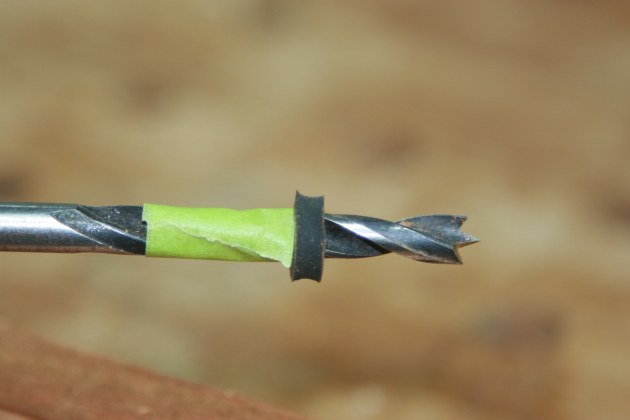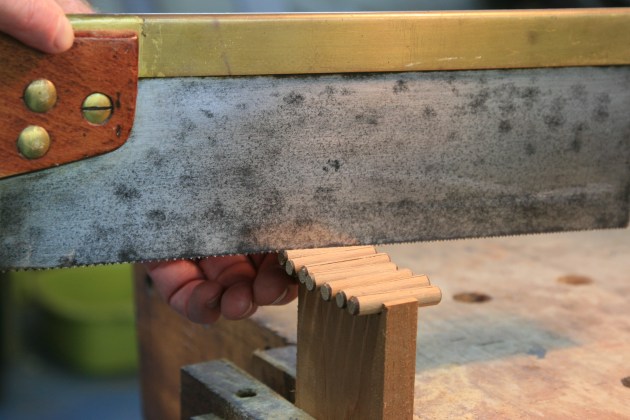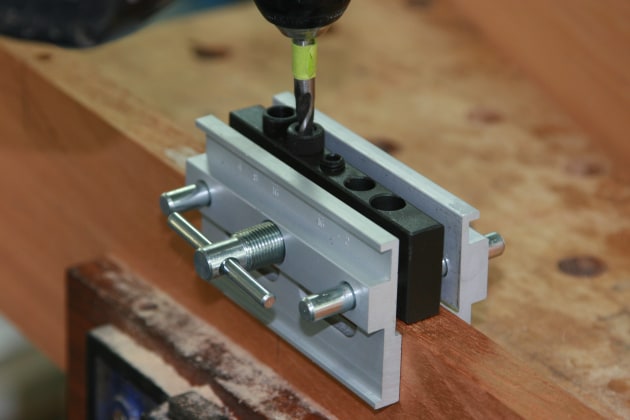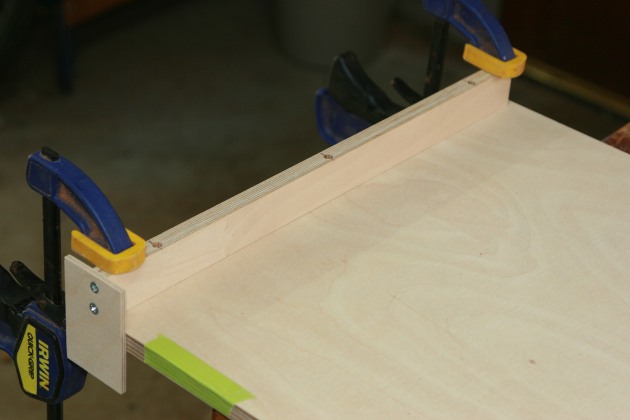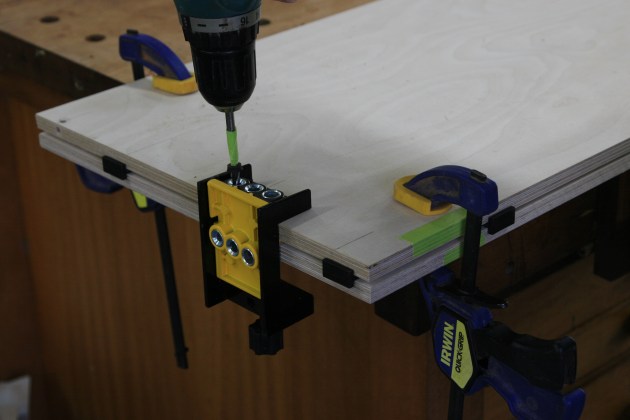How to use dowels (and avoid dowel joint failures)
Words and photos: Peter Young
There are many different ways to join pieces of wood or ply together. Some methods, like hand-cut mortise and tenon joints, require a reasonable level of skill. Other methods like biscuit joints or machine-cut mortises, require an investment in machinery.
Using dowels can be an effective way of achieving a good outcome but the humble dowel is now often overlooked because it has been associated with cheap and nasty furniture with a high failure rate. The fact is though, that dowels have long served as a reliable and cost effective means of joinery for commercial furniture manufacture.
Dowels may not be appropriate where a very strong joint is required, for example, on a chair where the seat rail and leg stile intersect. But there is a good case to be made for using dowels in many other situations where alignment is important and the strength of a dowel joint is sufficient.
For the part-time woodworker the advantage of using dowels is low cost and the low level of skill required. However there are some things worth knowing about the appropriate use of dowels to avoid joint failures. The famed James Krenov used dowels frequently in fine cabinetry and describes their use in his seminal work The Fine Art of Cabinetmaking. According to Krenov, ‘The whole secret of dowelling, and it is somewhat of a secret because of lack of common knowledge, is accuracy’.
Edge joining
In this situation you would be making a larger solid wood panel out of a series of narrower boards — for example
a tabletop or a benchtop. The long grain joints are very strong so dowels are not required to add strength but they do assist with alignment. You could also use biscuits or splines but both these methods require access to machinery.
1. Starting with boards that have been thicknessed and edge jointed (by hand or machine methods) make a pencil mark across two adjacent boards and then continue this line down the narrow edge of each board. Now use a pin marking gauge, set for about half the thickness of the board to mark the position of the dowel hole.
2. Make sure you use the corresponding surface of each board to reference the gauge. now drill the hole using a brad point drill the same size as the dowel you intend to use, making sure the hole is vertical. You will need to use a depth stop of some kind, in this example I am using a rubber washer supplied in a kit by Haron, backed up with some painters tape. I always like to check the depth of the hole just to make sure it is just over half the length of the dowel I am using.
3. You might want to take a few minutes to make a jig to assist with this operation. Drill a hole through a wood or ply scrap using the drill bit you will use for the dowel hole. Now glue and screw some ply to the scrap to provide a registration face which can be clamped to the board. Mark a line across this to line up with the centre line of the hole. This line registers against pencil marks you have made on the boards to be joined together. A simple jig like this will give you the accuracy you need to get good alignment.
Dowels can be purchased either fluted or plain and either pre-cut or in lengths. My preference is to purchase lengths of dowel and then cut to size. Fluted dowels allow glue to escape from the bottom of the hole where it might otherwise prevent the dowel from going the full depth. If you buy non-fluted dowel in lengths it is a good idea to make a shallow saw cut along the length to allow for glue escape.
4. Handling short lengths of dowel can be tricky so I make a simple jig to hold the dowels while I saw them. In a wood scrap I drill a series of holes the same diameter as the dowel, and then I cut through the scrap to remove about a third of the diameter. The dowels can now be pressed into the open holes, and with the scrap clamped in a vice, it is easy to make a shallow saw cut. I also use a pencil sharpener to cut a small bevel on each end of the dowel to make it easier during glue up to get the dowel into the mating hole.
5. You can also use a commercial jig for edge joining with dowels. The Eagle is a sturdy self-centring jig which can accommodate five dowel thicknesses — 1/4", 5/16", 3/8", 7/16" and 1/2".It is very easy to use, just align the marker on the body of the jig with the mark on the face of the board and drill to the required depth. You do need to provide your own drill and depth stop.
Corner joints
6. Another place where dowels are used is for corner joints of plywood cabinets. Krenov also used dowels for offset corner joints in solid wood cabinets. It is easy to make a Krenov style jig using plywood offcuts the same thickness as the cabinet. I make mine about 30mm wide and as long as the width of the cabinet. Use a drill press to drill three or more holes the same size as the dowel you are using and then screw a piece of scrap on the front to act as a stop. I use green painters tape on the front edges of the cabinet as an easy visual reminder of where to locate the jig stop, then I clamp the jig in place and drill the holes into the thickness of the ply cabinet. in this example I am using 12mm ply and a 6mm dowel and I would normally make the dowel hole about 8mm deep.
7. To drill the mating surface, place the ply in a vice and clamp the jig on the end of the ply, and then drill the holes.
8. I have found that making these holes 20mm deep reduces the amount of racking in the cabinet when it goes together.
Haron also make an inexpensive jig for this purpose (the H6500 Dowel Jointer). The kit comes with a drill bit,
depth stop, spacers and three sizes of dowel (6, 8, 10mm) are supplied. The instructions are well illustrated and easy to follow.To use the jig, the two boards to be joined are placed one on top of the other with the supplied spacers
in between.

9. It is then a matter of aligning the appropriate drill guide hole with your pencil marks on the top board and drilling the two mating holes before moving the jig to the next mark. Because I like to have deeper holes in the vertical ply member, I then transfer it to a vice and deepen the holes.

10. Both the shop made jig and the Haron jig provide good accuracy so the corners go together easily during assembly. One of the main advantages of (long) dowels over biscuits for this purpose is that dowel joints do not need clamps to keep the frame in place which greatly eases assembly when you are working by yourself.

11. I used this technique for a cabinet carcase which is made from 12mm Baltic birch plywood with blackwood lipping. The plywood end panels are doweled to the legs, which are in turn doweled to the plywood carcase. This quick and easy method of construction allows me time to spend on details such as marquetry while still keeping the price at a reasonable level.

12. If you buy dowel in lengths and cut it to size, it is a good idea to have a quick and reproducible method to get even lengths. I use a piece of ply in a vice as a stop and clamp a cutting board in place to give the desired length.
Rail to stile joints
The other joint where dowels can be used is the rail-stile joint of a frame and panel door, say for a cupboard. This is an area where some judgement is required as perceived wisdom, backed up by some testing, indicates that a dowel joint is not as strong as a traditional mortise and tenon joint. There are a lot of factors involved, such as the material from which the dowel is made, how long the dowels are and how many dowels are used in the joint. My own view is that a dowel joint would be quite acceptable in this situation provided that a plywood panel is used and that it is glued in place. I would also use dowels whose length are at least two-thirds the width of the stile.
A somewhat similar joint is the apron to leg joint of a table base. This is a situation where I would hesitate to use dowels as, unlike a door, the other end of the leg is not secured and acts as a long lever around the fulcrum of the apron-leg joint, exerting considerable force. if you did want to use dowels in this situation, you would definitely need to add glue blocks or a metal corner brace.
Jessem make an excellent jig (Model 08300) for accurate drilling of dowel holes for a rail-stile joint. The jig may also be used for edge drilling. A series of five ports allows up to five holes to be drilled at the same time. A 3/8" drill bit and a stop collar are provided. To show this here I used 64 x 19mm clear pine and lengths of 9.5mm fluted dowel. To get an accurate fit when using this type of non-self-centring jig it is important to always work from the face side of each piece. The instructions are reasonably clear and well-illustrated, although everything is in imperial measurements.

13. After setting the depth gauge (I made a 40mm deep hole) the stile piece is clamped in the jig and the holes bored.

14. The jig allowed three holes to be drilled to accommodate a 64mm wide rail.


15, 16. Once all the stiles have been drilled, the rails can be drilled without making any changes to the jig set-up. now it is simply a matter of slipping the dowels in place and fitting the other part of the joint.


17, 18. The alignment of the two pieces was excellent to give a nice clean joint which would require no clean up.
If you have access to a drill press it would not be difficult to make your own jig using an offcut of the rail or stile material and attaching a clamping plate to it. However you would have to make a new jig each time you used stock of different dimensions.
With some thought and judgement, there is definitely a place for using dowels in furniture making. The major issue is one of accuracy. Using either shop made or purchased jigs it is not difficult to get good fitting accurate joints with a minimal amount of time and money.
Peter Young is furniture designer maker who lives in NSW and teaches at Sturt School for Wood, Mittagong.





